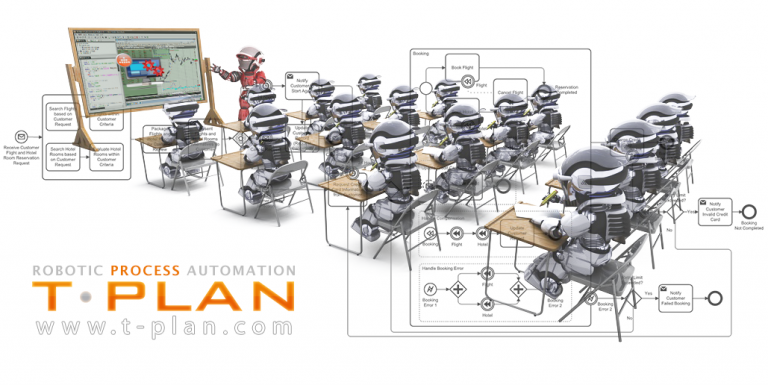Your Virtual Workforce
RPA Architecture
RPA Architecture
Our RPA solution is very flexible and can be setup to support many different hardware and software implementations.

Authoring of Automation
The first stage of any automation is the authoring of the business process or applications. This is performed using our java based T-Plan Robot software which has been used for developing GUI Automation workflows for 10 years.
Virtualised or Desktop Deployment
Most RPA solutions will be a mixture of real PC’s and virtual machines. Our solution can cope with any such setup. I.e. A mixture of VM’s and desktops, or one or the other…
The setup of automating environments generally falls into 2 main setup architectures:
- Virtual Controller
A ‘master’ robot (controller) controls the automation of multiple desktops as part of a business process or operation. The advantage of this setup is that one process can control the automation of information across different environments. E.g. Data automation between the operating systems of Windows, Mac and Linux. In this scenario each controller is managed by the RAP (Robot Automation Portal). - Local Desktop
Each desktop is controlled by an individual robot, acting as an automation agent residing on that machine or VM. The advantage of this setup is that each machine runs autonomously, and is managed directly from the RAP (Robot Automation Portal).
Virtual Controller
T-Plan’s RPA solution is unique in that it supports any configuration of automation running on Mac, Windows or Linux.

The image above shows a typical configuration, when a closed internal network is used to automate actions and transfer information, seamlessly between different environments.
Local Desktop
In situations where VNC (Virtual Network Computing over RFB) or RDP (Remote Desktop Protocol) types of connection are not possible, for reasons for example of network isolation, automation at the local desktop level is supported.

Security
Robot runs on desktop of local machine or VM. Automation occurs at desktop level & within security protocols just like a ghost user.
Cross Platform
Automation of business process information & applications within local machine or VM.
Business Process
Business process automation runs from within machine executed on.
Scalability
Very scalable as many desktops or VM’s can be run. No local machine controller required.
Security
Automation occurs over VNC or RDP channel with NO software installed on local machine or VM. I.e. footprint free, vanilla automation.
Cross Platform
Over VNC or RDP automation can happen easily across environments or machines.
Business Process
Automate business processes & applications across a Mac, Linux or Windows desktop.
Scalability
Recommended maximum of 5 desktops or VM’s to be linked to an individual controller machine.

